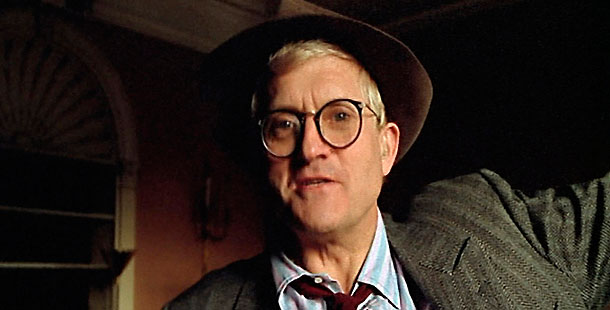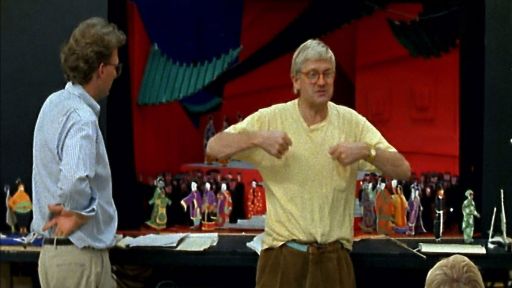One of the best-known artists of the twentieth century, David Hockney is renowned for his prolific production, high level of technical skill, and extreme versatility. He has achieved renown in a wide variety of media including pen-and-ink drawing, painting, printmaking, and photography. Alongside the quality of his work, his round face and owlish glasses have made him one of the most recognizable artists working today.
Hockney was born on July 9, 1937 in the industrial town of Bradford, in Yorkshire, England, to a working-class but politically radical family. Although his father, Kenneth, ran an accounting business, he was also an antiwar activist who wrote letters of protest to world leaders. David was the fourth of five children. His mother, Laura, was a shop assistant and a strict vegetarian.
By the time he was 11, Hockney had already decided to become an artist. He studied at the local Bradford School of Art from 1953 to 1957, where he acquired an early reputation as a skilled draftsman. After fulfilling his National Service duties as a conscientious objector by working in a hospital for two years, Hockney enrolled at the London College of Art in 1959. He excelled there as well, both socially — his outgoing, gregarious personality won him a number of friends, most notably the painter R. B. Kitaj — and professionally — he discovered modernism, his work in the Young Contemporaries show in 1961 led critics to dub him one of the rising stars of the pop movement, and he won the College’s Gold Medal in 1962. Academically he lagged, though, flunking out twice before the school finally allowed him to graduate.
Hockney’s early work was characterized by a sort of false amateurism (“faux-naif”), in which he mixed sophisticated, highly skilled technique with intentionally crude folk-art styles. He often scrawled lines of poetry or other text over his works that related to their meaning. His influences throughout this period included Jean Dubuffet and Pablo Picasso, and Hockney’s own homosexuality (for example, a series of paintings in 1960-61 titled We Two Boys Together Clinging takes its name from the Walt Whitman poem). His 1962 series Demonstrations of Versatility was a dazzling collection of paintings, each in a different style, that showcased Hockney’s skill and creativity.
Hockney was an avid lithographer as well; some of his best-known work from this period includes 1961’s Myself and My Heroes, in which he appears alongside Mahatma Gandhi and Walt Whitman, and his 1961-63 The Rake’s Progress, an updated version of a series of William Hogarth prints from 1732-33. In 1975, Hockney designed the sets for a production of the opera inspired by the prints at the Glyndenbourne Festival in Australia.
Unlike most of his contemporaries, upon graduation from art school Hockney had already established himself well enough professionally that he didn’t have to take a teaching position and could work full-time as an artist. In 1963 he moved to California. Settling in Santa Monica, he began working with acrylic paints instead of oils and adopted a more realistic style, winning acclaim for a series of rich, colorful paintings of swimming pools. Hockney fell in love with California’s sunny weather, its cleanness and spare beauty, its social freedom, and the beauty of its inhabitants. Many of his works during this period were “snapshots” of men in casual poses, engaged in activities such as swimming; Neil Simon’s 1978 film California Suite used a number of them in its opening credits. During this period Hockney also painted several critically acclaimed portraits of his friends; one of these, Mr. and Mrs. Clark and Percy, is considered by authorities at the Tate Museum to be the most popular painting in the museum’s collection.
In 1966 he met native Californian Peter Schlesinger, who became his romantic partner and frequently modeled for him. The two moved back to London together, but broke up in 1970. In 1973 Hockney moved to Paris briefly, where he spent part of his sojourn living in an apartment in the Quartier Latin formerly owned by the painter Balthus. While in Paris he produced a series of etchings in memory of his idol Picasso, who had died that year, and produced a 1974 exhibition at the Musée des Artes Decoratifs with the help of two of Picasso’s master printers, Aldo and Piero Crommelynck.
Throughout this period Hockney continued to explore other media besides painting, most notably photography. From 1982-86, he created some of his best-known and most iconographic work — his “joiners,” large composite landscapes and portraits made up of hundreds or thousands of individual photographs. Hockney initially used a Polaroid camera for the photos, switching to a 35 mm camera as the works grew larger and more complex. In interviews, Hockney related the “joiners” to cubism, pointing out that they incorporate elements that a traditional photograph does not possess — namely time, space, and narrative.
Always willing to adopt new techniques, in 1986 Hockney began producing art with color photocopiers. He has also incorporated fax machines (faxing art to an exhibition in Brazil, for example) and computer-generated images (most notably Quantel Paintbox, a computer system often used to make graphics for television shows) into his work.
In 2001 Hockney set off controversy in the art world with his film Secret Knowledge, in which he advances a theory that many Old Masters (particularly Jeane-August-Dominique Ingres, but others as well) achieved the extreme realism of their works through the use of a “camera lucida” (a series of lenses and prisms), projecting an image of their model onto the canvas and then tracing around it. This theory has not drawn much support among art historians, however.
Hockney also has a long history in stage design, particularly for operas and the dramatic theater. He designed the set for the Royal Court Theatre’s production of Alfred Jarry’s play UBU ROI in 1966, and has done design work for the Metropolitan Opera in New York City as well as operas in Philadelphia and Los Angeles.
Hockney currently divides his time between the Hollywood Hills and Malibu.
— Brian Kennedy
Brian Kennedy is a freelance writer living in Brooklyn.



